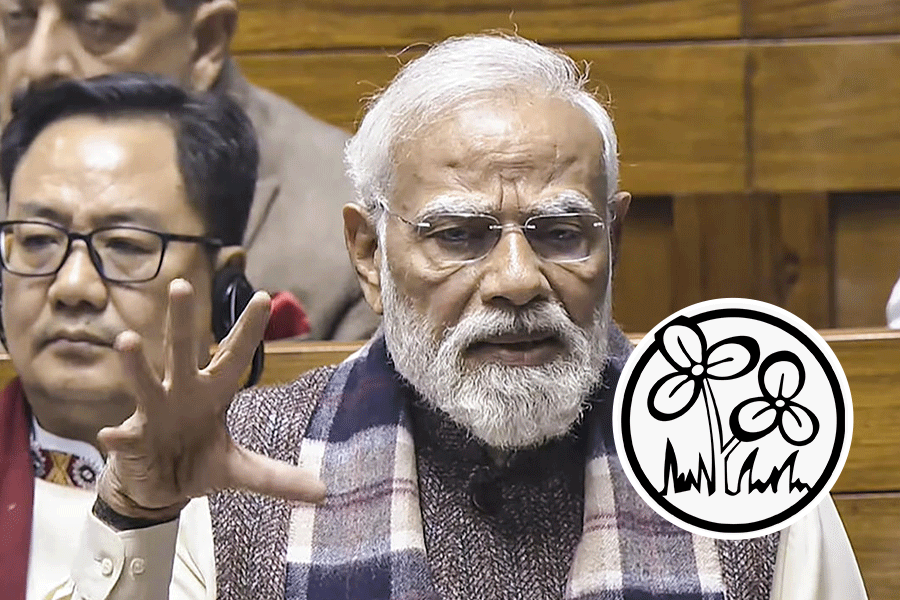 |
 |
| BURNING ISSUE: Protesters in Calcutta burn the chief minister’s effigy after the police action at Nandigram. (below) Villagers in Shengyou in China’s Hebei Province who have refused to give up their land for development |
The farmers came in hundreds. At stake was their rich land, which the government had acquired for a construction site. The violence that followed was not unexpected. And even a week later, the number of casualties is not clear.
Sounds familiar? It could have been an incident in Nandigram — but the farmers’ protest — and the ensuing violence — occurred in China. From its southern Guangdong province to Nandigram, Jagatsingpur in Orissa to Singur in Bengal, Konkan in Maharashtra to Dadri in Uttar Pradesh and Barnala in Punjab — it’s the same story, with peasants resisting government attempts to take away their land for new industries or special economic zones (SEZ).
Last Sunday, strife broke out in Shanwei in Guangdong Province. Villagers fought with hired thugs over a land dispute involving a power plant construction site. About 70 villagers were shot dead in Shanwei in December, 2005, in a conflict over the same power plant.
Proponents of SEZs in India often buttress their case by pointing to China’s success with them. But they neglect to mention how rising discontent over intrusive land acquisitions is emerging as the greatest threat to the Middle Kingdom’s political stability. Almost 90,000 public protests exploded across China last year and a large number of them were over land seizures, activists say.
The message is loud and clear: people are rejecting government ideas of development. And that is because, as sociologist Abhijit Pathak of Jawaharlal Nehru University says, they feel that there is “no place for them in these mega projects that symbolise the ruthless techno-economic face of hegemonic capitalism”.
Economist Arun Kumar believes the resistance shows that the displaced peasants are not prepared to be the “underbelly of the nation, thrown into an uncertain, pauperised future.” Many like him see in the resistance the people’s rising aspiration for a better quality of life.
But in Bengal’s case, do the protests also mean the end of modern industrialisation even before it has begun? Bengal’s commerce and industries minister Nirupam Sen answered the question during a discussion in the state Assembly on Thursday.
Despite the bloodbath at Nandigram, he said, Bengal’s industrialisation will not slow down. Industrialisation, he held, is the only way to create jobs for the new generation of educated young villagers.
Neither does CPI(M) central committee member Nilotpal Basu think that Nandigram will scare off would-be investors. “This question may lose its relevance a few weeks from now,” Basu says.
Businessman Harsh Neotia agrees, stressing that he does not see the people’s resistance as a rejection of industrialisation. And C.K. Dhanuka, chairman of the Federation of Indian Chambers of Commerce & Industry’s eastern region council, holds that the violence will have no impact on investment in Bengal. “If anything, the investment climate is getting better by the day, with a government committed to industrialisation,” he says.
In private, though, most CPI(M) leaders admit that things cannot be the same after Nandigram. Nandigram, they hold, has signalled the end of the road for SEZs in Bengal — for a long time.
Bengal may do well to recall the story of China. In the early years of China’s reform process, economic zones helped drive the country’s progress by creating concentrations of industry in backward areas where land and labour were cheap. Economists estimated that these SEZs contributed as much as 40 per cent of China’s GDP in the 1980s.
But the glitter of the new cities often hid ugly truths. In some areas, up to 90 per cent of the giant developments that fuelled the Chinese economy had been built on illegally acquired land, Chen Changzhi, a vice-minister in the ministry of land and resources, said recently. Citizens’ groups say that more than 80 per cent of the 11,500 square miles of farmland acquired for development had been acquired by fraudulent means.
But now Communist Party leaders who once seized land from feudal lords and gave it to the poor, like their counterparts did in Bengal, are worried. “We absolutely cannot commit a historic error over land problems,” Chinese Premier Wen Jiabao said in a recent speech, where he also warned local officials that the requisitioning of land without adequate compensation or arrangements for the livelihood of farmers was threatening social stability.
There is rethinking in Bengal too. Insiders believe that except at Singur, where work on the Tata small car project goes on under massive police cover, the government will go slow on all projects. Already, people elsewhere have been stepping up their resistance to new projects. Within days of the Nandigram killings, government officials and consultants of an engineering firm surveying land for the Barasat-Raichak Expressway were sent packing by the local people.
In China, too, the protests carry on, undeterred by state intimidation. A new fight-back mechanism for dispossessed peasants is to challenge land acquisitions in China’s nascent judicial system. “People tell me, ‘How can you make your government your adversary’,” says Lu She Zhong, a crusty 57-year-old village leader in central Shanxi province who is leading his community in suing the local government for pushing them off their land to make way for the giant Xiaolangdi dam without adequate compensation.
Other dispossessed peasants say they will chain themselves to their property and even kill themselves if they are forced to surrender their homes without fair compensation. “I don’t mind supporting the nation and its projects, but why should we not get paid for our land when others will make money from it,” asks Fang Degui, a farmer in Guangtiangou commune in central Chongqing, whose house will be submerged by the Three Gorges Dam’s reservoir.
But the protests are not to be seen entirely as a message of doom. The resistance may spur governments and planners to make development a matter of “inclusive dialogue” and to negotiate with people’s representatives. Basu, in fact, stresses that the CPI(M) will have “extensive consultations” with the people about future projects.
In China, too, Premier Wen has launched a series of moves to quell the growing public outrage over land acquisitions. Last Friday China’s parliament passed a landmark property rights bill. The new legislation is hardly comprehensive, but it gives citizens so many rights that Communist Party hardliner Gong Xiantian, an expert in Marxist economics at Peking University, has said it will “undermine the legal foundation of China’s socialist economy.”
One reason current Premier Wen Jiabao can afford to give Chinese citizens these protections is that after almost 30 years of hard-nosed development largely built around land grabs and other such morally cumbersome practices, the Chinese economy is strong enough to embrace a kinder, gentler approach. In fact, government analysts say a more coherent legal and financial system is the key to moving China away from its current low-cost manufacturing economy and towards high-value innovation-driven industries.
In Bengal, many believe that the people will have to be made stakeholders in development. Their resistance carries the message that India cannot have a deepening of democracy along with industrialisation imposed against the people’s will.
Buddhadeb Bhattacharjee may love to be Bengal’s Deng Xiaoping; but he could also learn his lessons from the land riots and ensuing moves in China.
(With additional reporting by Debashis Bhattacharyya in Calcutta)










